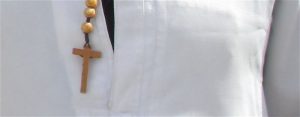Then I saw another angel coming up from the east, having the seal of the living God. He called out in a loud voice to the four angels who had been given power to harm the land and the sea: “Do not harm the land or the sea or the trees until we put a seal on the foreheads of the servants of our God.” (Rev. 7:2-3)
The cross, in the Christian understanding, is the symbol of Easter. The Crucifixion happened on a cross, and the shape of the cross became a Christian symbol; it is certainly not a Jewish mark today. On the contrary, it has at times been used as a sign against the Jews. The Jewish people have often seen it as the mark of the enemy, and for good reason.
So why ask about the Jewishness of the cross, a mark so integrated into Christian life? In the Orthodox, Catholic, and many other churches the cross has developed into more than something you look at. The cross mark is used actively, by drawing it in the air as a blessing or over the individual, for example at baptism. Let us look at the subject from another angle.
After God had confronted Cain with the killing of his brother, Cain cried because of the terrible consequences of his sins. God had the right to avenge Abel’s death; instead he marked Cain on his forehead as a sign of God’s own protection.
In Ezekiel 9:4-6, we again hear about the mark on the forehead: the prophet is to mark the righteous people with the Hebrew letter tav. Why tav? It is obvious that the purpose is to show the relation to God. The tav is a symbol for God. This is also how the Talmud (Shabb 55a) explains this text. Tav is the last letter in the Hebrew word emet, truth, a word for the Almighty. We know of this symbolic Jewish use of tav  from other sources as well.
from other sources as well.
So when we hear about the mark, the seal on God’s people in Revelation (7:2–3 and other verses), it is obvious that John is using the texts from Ezekiel and linking them to already established concepts. God’s people are to be marked with the mark that symbolizes God. In other words, it is the biblical and Jewish mark of tav.
What is the connection to the cross? The shape of the tav in the old Hebrew alphabet used during the time of Ezekiel was that of an X or a +. We can assume that people at the time of Jesus knew both alphabets, just as we today can read Latin and Gothic letters. The symbolic meaning of the shape X or + was therefore known—the symbol of God and of salvation.
Perhaps the best way to understand why the cross so rapidly became an important Christian symbol is to understand it as an already established biblical, Jewish symbol. In other words, Jesus was crucified on a cross that had the shape of a tav, and thus he added meaning to this mark.
The crosses of the Orthodox churches more often have the shape of the + and not the cross shape of the Western Church, †. Is that because they are closer to the Jewish homeland, and so remain closer to the original Jewish symbol?
Adapted from the Caspari Center newsletter, 1995.
Torkild Masvie